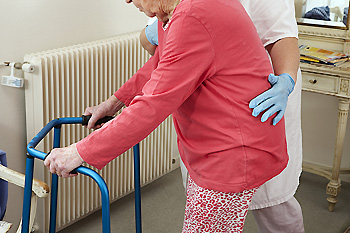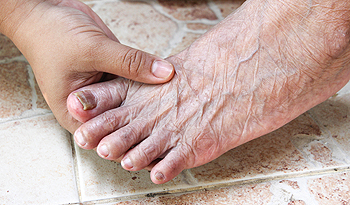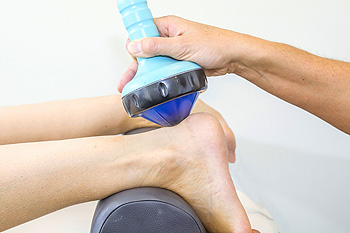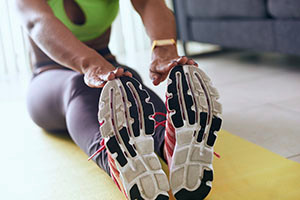Items filtered by date: July 2022
Prevent Falls With Specific Exercises

Suffering from a fall as a senior citizen is no joke. As an individual ages, they become more prone to tumbling and tripping both inside and outside of their home. These falls can be life-threatening and may occur on staircases or hard, dangerous surfaces. Although falls may happen for any number of reasons, the health of a senior’s feet can be an influential factor. Therefore, one way to prevent falls from occurring in senior citizens is to strengthen the feet by practicing several simple exercises. These exercises can improve the strength in the senior’s feet muscles and increase balance. One such exercise is known as leg extensions and can be performed by repeatedly extending and raising one leg at a time while sitting in a chair. You can alternate the legs after each extension. The purpose of this exercise is to increase strength and agility in the leg muscles. If stretching seems boring or unappealing, a senior might also try to improve the strength of their feet by walking, practicing tai chi, or performing simple movements in the pool. If you are a senior who is concerned about their likelihood of suffering from a fall, you can contact a podiatrist for more information about strength-building exercises.
Preventing falls among the elderly is very important. If you are older and have fallen or fear that you are prone to falling, consult with Dr. Odin De Los Reyes from Connecticut. Our doctor will assess your condition and provide you with quality advice and care.
Every 11 seconds, an elderly American is being treated in an emergency room for a fall related injury. Falls are the leading cause of head and hip injuries for those 65 and older. Due to decreases in strength, balance, senses, and lack of awareness, elderly persons are very susceptible to falling. Thankfully, there are a number of things older persons can do to prevent falls.
How to Prevent Falls
Some effective methods that older persons can do to prevent falls include:
- Enrolling in strength and balance exercise program to increase balance and strength
- Periodically having your sight and hearing checked
- Discuss any medications you have with a doctor to see if it increases the risk of falling
- Clearing the house of falling hazards and installing devices like grab bars and railings
- Utilizing a walker or cane
- Wearing shoes that provide good support and cushioning
- Talking to family members about falling and increasing awareness
Falling can be a traumatic and embarrassing experience for elderly persons; this can make them less willing to leave the house, and less willing to talk to someone about their fears of falling. Doing such things, however, will increase the likelihood of tripping or losing one’s balance. Knowing the causes of falling and how to prevent them is the best way to mitigate the risk of serious injury.
If you have any questions, please feel free to contact our offices located in Southbury and Farmington, CT . We offer the newest diagnostic and treatment technologies for all your foot care needs.
How to Avoid Potential Foot Conditions in Elderly People

It is normal for the feet to flatten and become wider as the aging process occurs. As the fatty padding gradually wears down, the joints and bones of the feet are more susceptible to basic wear and tear. Range of motion and balance may be negatively affected, and injuries can happen more frequently. Foot care for the elderly can start with washing and drying the feet thoroughly every day, and this may be helpful in preventing bacterial, fungal , and viral infections. This is generally followed by applying a good moisturizer on the feet, which may help to prevent cracked heels from developing. Many people wear cotton socks after this, and this can help to lock in the moisture. When the toenails are properly trimmed, conditions that can include ingrown toenails may be avoided. Many elderly people are confined to a bed or chair for the majority of the day, and bedsores on the heels may develop as a result of this. This can be remedied by raising the heels in the air, which is known as “floating the heels’. There are additional ways that can help elderly patients take proper care of their feet, and it is suggested that you speak with a podiatrist to learn about these methods.
Proper foot care is something many older adults forget to consider. If you have any concerns about your feet and ankles, contact Dr. Odin De Los Reyes from Connecticut. Our doctor can provide the care you need to keep you pain-free and on your feet.
The Elderly and Their Feet
As we age we start to notice many changes in our body, but the elder population may not notice them right away. Medical conditions may prevent the elderly to take notice of their foot health right away. Poor vision is a lead contributor to not taking action for the elderly.
Common Conditions
- Neuropathy – can reduce feeling in the feet and can hide many life-threatening medical conditions.
- Reduced flexibility – prevents the ability of proper toenail trimming, and foot cleaning. If left untreated, it may lead to further medical issues.
- Foot sores – amongst the older population can be serious before they are discovered. Some of the problematic conditions they may face are:
- Gouging toenails affecting nearby toe
- Shoes that don’t fit properly
- Pressure sores
- Loss of circulation in legs & feet
- Edema & swelling of feet and ankles
Susceptible Infections
Diabetes and poor circulation can cause general loss of sensitivity over the years, turning a simple cut into a serious issue.
If you have any questions please feel free to contact our offices located in Southbury and Farmington, CT . We offer the newest diagnostic and treatment technologies for all your foot and ankle needs.
Why Live with Pain and Numbness in Your Feet?
Shockwave Therapy for Plantar Fasciitis

Plantar fasciitis is a foot condition that causes inflammation and pain in the connective tissues on the bottom of the feet. This can cause the foot to swell and feel tender, particularly the heel. Shockwave therapy is a non-invasive option that can be used to treat plantar fasciitis. It uses high-frequency sound waves, or vibrations, and heat to help break down scar tissue and reduce inflammation and pain. Usually, multiple sessions are done so that pain is worked through gradually. It is gentle and safe for the body and can be used with other treatments, such as cortisone injections and physical therapy. If you are experiencing pain from plantar fasciitis, please consult with a podiatrist who can talk to you about this treatment and other options for providing relief.
Shockwave therapy is a treatment commonly used to treat various injuries and conditions, particularly plantar fasciitis in the feet. To learn more, consult with Dr. Odin De Los Reyes from Connecticut. Our doctor can provide the care you need to keep you pain-free and on your feet.
Shockwave Therapy
Shockwave therapy is a new treatment option designed to treat bone conditions such as tennis elbow, shoulder pain, and others. Shockwave therapy uses high intensity sound waves that are directed to the affected tissues of the body with pinpoint accuracy. The effects are very beneficial, leading to a production of collagen fibers, eliminating inflammation.
Who Benefits from Shockwave?
Shockwave is recommended for patients suffering from heel pain and associated problems. Heel pain is a common condition which can be caused by obesity, overexertion, and spending a substantial amount of time on hard floors with your feet exposed and unsupported.
Fast and Easy
The therapy is actually a simple process that can leave patients feeling better the very next day. Shockwave therapy is not as dramatic as it sounds. It enables more blood flow to effected areas, addressing the source of the problem and allowing treatment to last for a long time.
Treatment & Recovery Time
Shockwave treatment will enable your feet to recover quickly. This is especially important since surgery is not required. It is cost effective and does not require the use of anesthesia. This treatment is a better option to surgery, since it is proven safe.
If you have any questions, please feel free to contact our offices located in Southbury and Farmington, CT . We offer the newest diagnostic and treatment technologies for all your foot and ankle needs.
Simple Methods That Can Help Prevent Running Injuries

The importance of knowing how to prevent running injuries is crucial for people who enjoy the sport of marathon running or light jogging. Research has indicated that approximately 50 percent of injuries can happen every year to people who run regularly. An injury to the Achilles tendon is a common running mishap, and this can cause severe pain and discomfort. It often happens as a result of increasing speed and intensity too quickly, which may rupture or inflame the Achilles tendon. An effective prevention technique is to warm up and cool down for several minutes, and gradually increase the force of the running. Many people develop and suffer from plantar fasciitis, causing severe heel pain. It can occur from not stretching the calf muscles before running, and prevention can be increased when range of motion is expanded in the overall foot. An ankle sprain occurs when the ligaments and tendons in the ankle become overstretched from rolling the ankle beyond its normal limitations. When the muscles are strengthened surrounding the ankle, the chance of incurring an ankle sprain may be decreased. If you would like more information about how running injuries affect the feet, and how to prevent them, please consult with a podiatrist.
Exercising your feet regularly with the proper foot wear is a great way to prevent injuries. If you have any concerns about your feet, contact Dr. Odin De Los Reyes of Connecticut. Our doctor will treat your foot and ankle needs.
How to Prevent Running Injuries
Many common running injuries are caused by overuse and overtraining. When the back of the kneecap starts wearing out and starts causing pain in your knee, this is commonly referred to as runner’s knee. Runner’s knee is a decrease in strength in your quadriceps and can occur if you’re not wearing properly fitted or supporting shoes. To prevent runner’s knee, focusing on hip strengthening is a good idea, as well as strengthening your quads to keep the kneecaps aligned.
What Are Some Causes of Running Injuries?
- One cause of a common running injury is called iliotibial band syndrome.
- Plantar fasciitis is also another common injury.
- Stress fractures can occur from overtraining, lack of calcium, or even your running style.
Best Ways to Prevent Running Injuries
- Wear footwear that fits properly and suits your running needs.
- Running shoes are the only protective gear that runners have to safeguard them from injury.
- Make a training schedule. Adding strengthening exercises as well as regular stretching can help keep you strong and limber and can lessen the possibility of injuries.
- Stretching keeps muscles limber; this will help you gain better flexibility.
If you have any questions please feel free to contact our offices located in Southbury and Farmington, CT . We offer the newest diagnostic and treatment technologies for all your foot and ankle needs.

